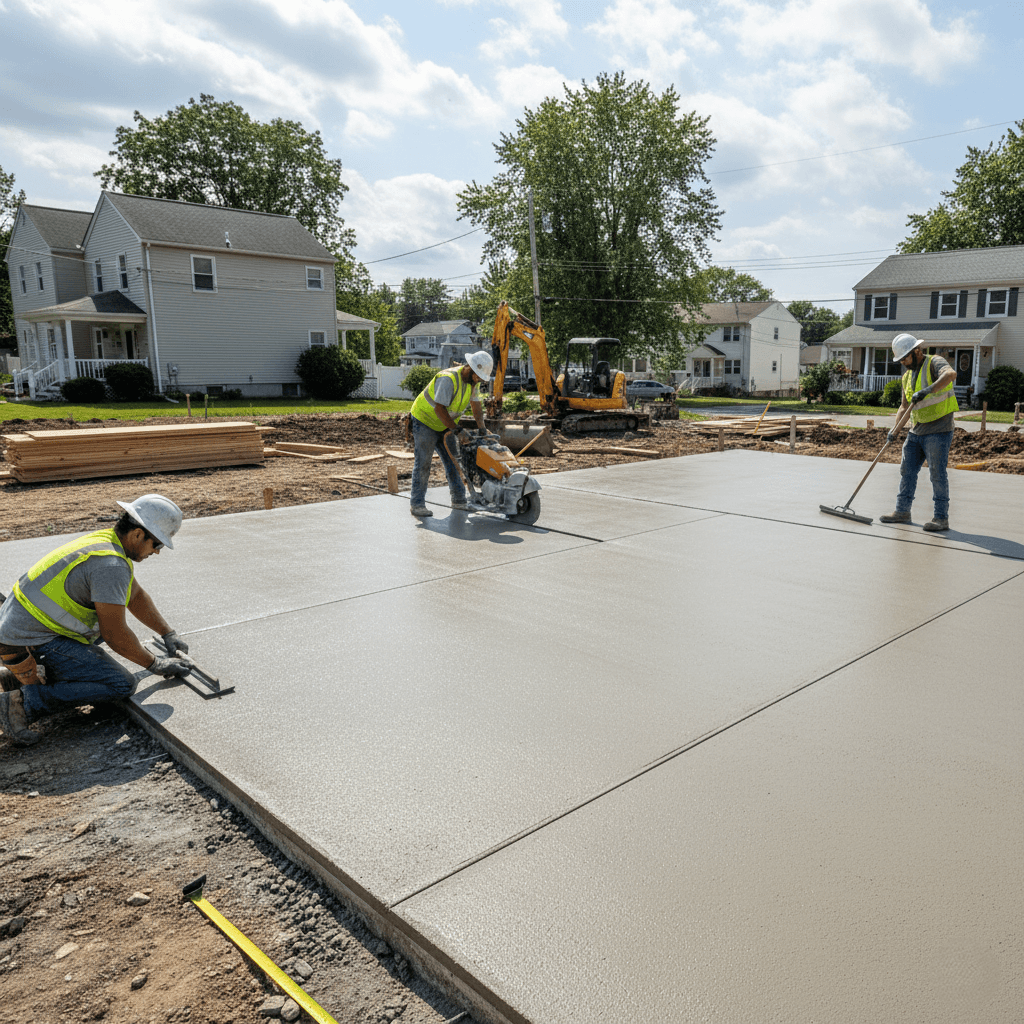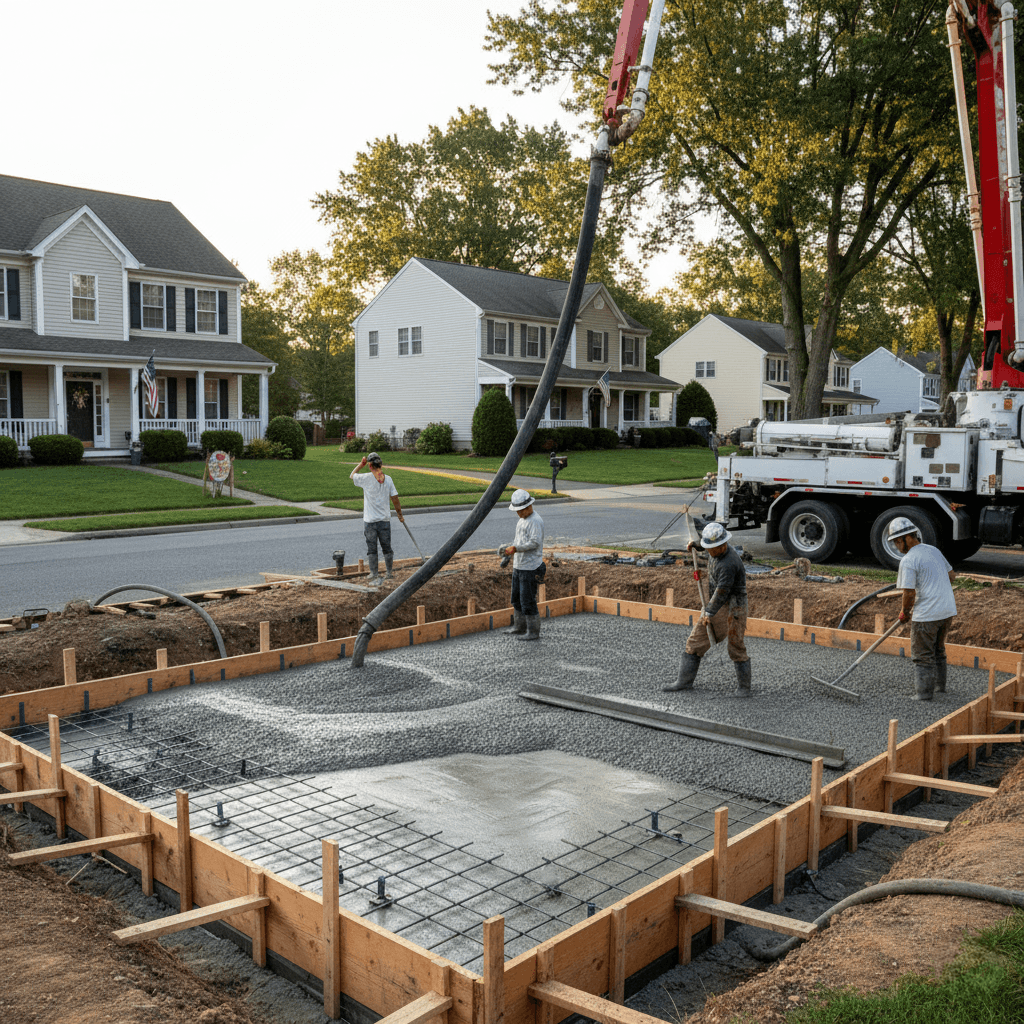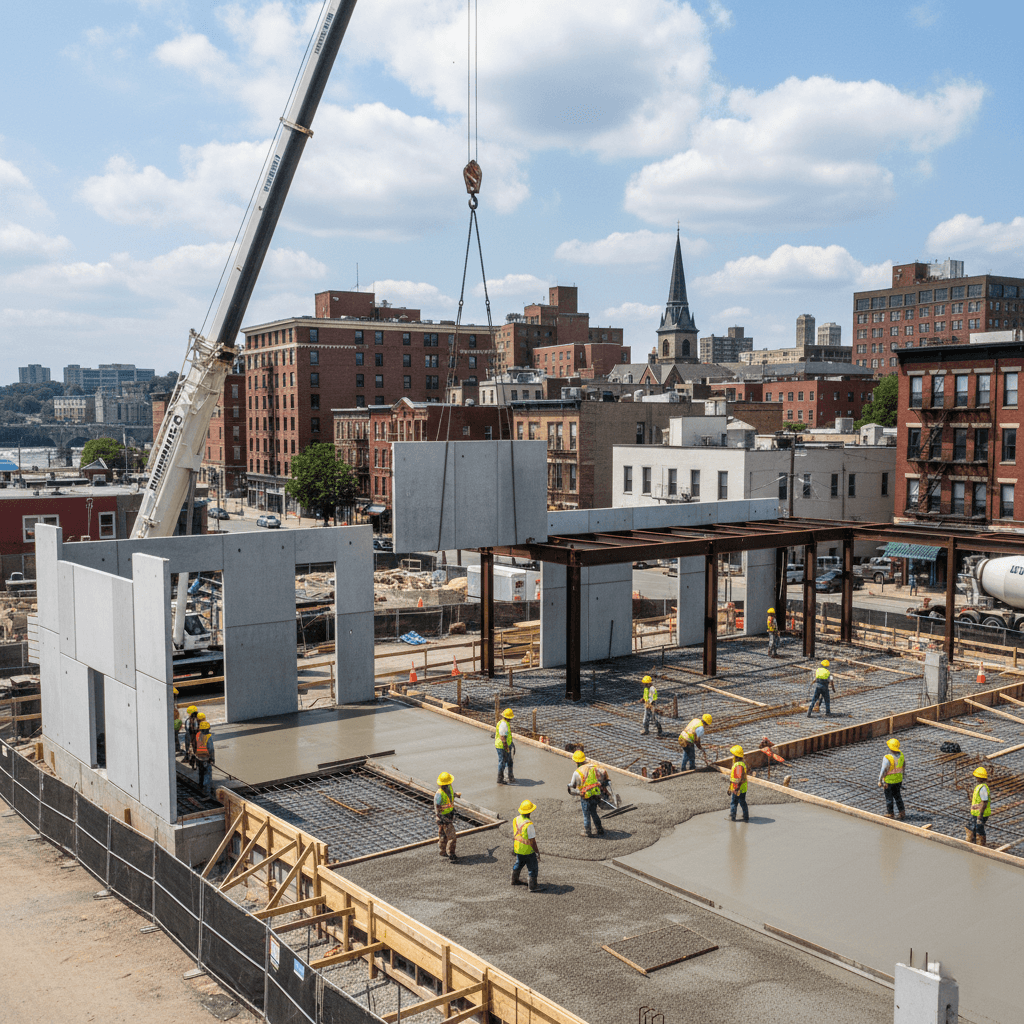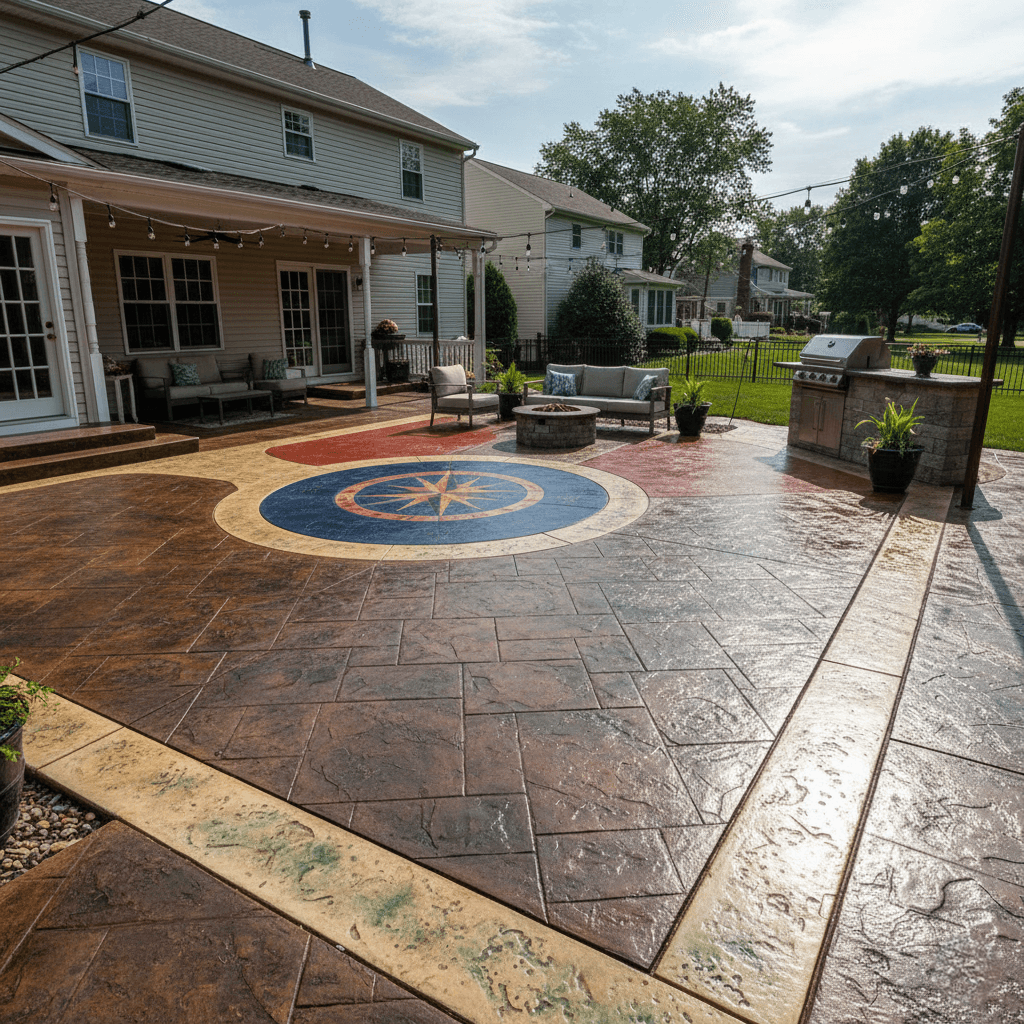
Paterson Concrete Slab Installation for Garages & Sheds
Concrete Slab Paterson
Properly sizing and pouring a concrete slab for garages and sheds in Paterson, NJ requires understanding local building codes, soil conditions, and load requirements specific to the intended use. A well-designed concrete slab provides the essential foundation for any structure while ensuring compliance with New Jersey’s strict construction standards. Professional planning considers factors including garage slab thickness, reinforcement specifications, and drainage requirements that directly impact long-term performance. Additionally, proper installation techniques and quality materials ensure the foundation can withstand Paterson’s challenging climate conditions, including freeze-thaw cycles. Moreover, following established procedures helps property owners avoid costly mistakes and ensures lasting structural integrity for their investment.

Understanding New Jersey Building Code Requirements
New Jersey building codes establish minimum thickness and strength requirements for concrete slabs based on intended use and structural demands. Paterson building codes require garage floors to have a minimum thickness of 3.5 inches with concrete strength of at least 3,500 psi for residential applications. Additionally, commercial or heavy-duty applications may require increased thickness up to 6 inches or more, depending on anticipated loads. Professional contractors understand these requirements and ensure compliance through proper design and installation procedures. Furthermore, shed foundation requirements vary based on structure size, with buildings under 100 square feet having different specifications than larger accessory structures.
Permit Requirements and Inspection Procedures
Most concrete slab installations in Paterson require building permits and inspections to ensure code compliance and structural adequacy. The permit process includes submitting detailed plans showing slab dimensions, thickness specifications, and reinforcement details for review. Moreover, inspections typically occur at multiple phases, including excavation, reinforcement placement, and final concrete installation. Professional contractors coordinate with Paterson’s Construction Code Enforcing Agency to schedule required inspections and ensure smooth project completion. Additionally, proper documentation and compliance prevent future issues with property sales or insurance coverage.
Determining Appropriate Slab Thickness and Sizing
Garage slab thickness depends on vehicle weight, traffic patterns, and intended use beyond simple car storage. Standard residential garages accommodating passenger vehicles typically require 4-inch thick slabs, while heavy-duty applications need 5-6 inches for trucks or equipment storage. Additionally, workshop areas or spaces housing heavy machinery may require increased thickness up to 8 inches or specialized reinforcement systems. Professional assessment considers soil conditions, drainage requirements, and local climate factors when determining optimal specifications. Furthermore, proper load-bearing calculations ensure the slab can handle anticipated weights without cracking or settlement issues.
Shed Foundation Sizing Considerations
Shed foundation planning involves evaluating structure size, intended use, and local soil conditions to determine appropriate concrete slab dimensions and thickness. Small utility sheds under 100 square feet may only require 3.5-inch-thick slabs, while larger structures need increased thickness for stability. Moreover, sheds storing heavy equipment or serving as workshops require enhanced foundations comparable to garage specifications. Professional evaluation considers factors including wind loads, frost depth, and drainage patterns that affect foundation performance. Additionally, proper sizing ensures adequate edge distances and reinforcement coverage for long-term durability.
Site Preparation and Excavation Requirements
Proper site preparation begins with accurate layout and excavation to establish correct elevations and drainage patterns. Excavation depth includes slab thickness plus base material, typically requiring 8-10 inches of total depth for standard installations. Additionally, soil evaluation determines compaction requirements and identifies any problematic conditions that need special treatment. Professional contractors use laser levels and survey equipment to ensure proper grades and elevations throughout the foundation planning process. Furthermore, adequate drainage provisions prevent water accumulation that could compromise foundation stability.
Base Material Installation and Compaction
Quality base material provides essential support and drainage for concrete slabs while preventing settlement and cracking issues. Standard installations use 4-6 inches of compacted gravel or crushed stone to create a stable, well-draining foundation layer. Moreover, mechanical compaction ensures uniform density and eliminates soft spots that could cause slab settlement or cracking. Professional installation includes proper base material selection based on local availability and soil conditions. Additionally, vapor barriers may be required under heated structures to prevent moisture migration through the slab.
Reinforcement Requirements and Specifications
Slab reinforcement requirements depend on thickness, load conditions, and local building code specifications for different structure types. Wire mesh reinforcement is commonly used in residential garage slabs to control shrinkage cracking and improve overall durability. Additionally, rebar reinforcement may be required for thicker slabs or heavy-duty applications to provide structural strength. Professional contractors understand reinforcement placement requirements, including proper coverage and support systems during concrete placement. Furthermore, seismic considerations in some areas may require specific reinforcement patterns and connection details.
Control Joint Planning and Installation
Control joints manage concrete shrinkage and prevent random cracking by providing predetermined locations for crack formation. Joint spacing typically equals 24-30 times the slab thickness, with maximum distances of 10-12 feet for residential applications. Moreover, joints must be properly sealed to prevent water infiltration and damage from freeze-thaw cycles. Professional installation includes saw-cutting or forming joints at appropriate timing to ensure clean, straight lines. Additionally, expansion joints may be required at building connections or where slabs meet existing structures.
Concrete Mixture Specifications and Ordering
Concrete mixture specifications must meet minimum strength requirements while providing adequate workability for placement and finishing operations. Standard residential garage applications require 3,500 psi concrete with air entrainment for freeze-thaw resistance in New Jersey’s climate. Additionally, specialized admixtures may improve workability, curing characteristics, or surface durability depending on specific project requirements. Professional contractors work with local suppliers to ensure appropriate mix designs and delivery coordination. Furthermore, proper concrete mixture specifications ensure compliance with building codes while optimizing performance and durability.
Calculating Concrete Quantities and Ordering
Accurate quantity calculations prevent shortages during placement while minimizing waste and cost overruns for the concrete pouring process. Standard calculations multiply length times width times thickness, then convert to cubic yards for ordering purposes. Moreover, adding 5-10% extra material accounts for waste, spillage, and minor variations in actual thickness requirements. Professional contractors use precise measurements and coordinate delivery timing to ensure continuous placement without cold joints. Additionally, backup plans for weather delays or other issues help maintain project schedules and quality standards.
Forming and Preparation for Concrete Placement
Proper forming establishes accurate slab dimensions, elevations, and edge conditions while containing concrete during placement and finishing operations. Forms must be straight, level, and adequately braced to resist concrete pressure and maintain desired shapes. Additionally, proper drainage slopes and thickness verification ensure compliance with design specifications and building code requirements. Professional installation includes checking all measurements and elevations before concrete delivery to prevent costly corrections. Furthermore, access routes and equipment positioning are planned to facilitate efficient concrete placement and finishing.
Weather Considerations and Timing
Weather conditions significantly impact concrete placement, curing, and final quality, requiring careful timing and protective measures when necessary. Optimal conditions include temperatures between 50-80°F with minimal wind and no precipitation forecasted during initial curing periods. Moreover, hot weather requires additional precautions, including cooling measures and extended curing protection to prevent rapid moisture loss. Professional contractors monitor weather forecasts and adjust schedules accordingly to ensure optimal concrete performance. Additionally, cold-weather procedures may be required during winter months to maintain proper curing temperatures.
Concrete Placement and Finishing Techniques
Professional concrete placement ensures uniform thickness, proper consolidation, and smooth surfaces free from voids or defects. Systematic placement patterns prevent segregation while maintaining consistent slab thickness throughout the entire area. Additionally, proper consolidation using vibrators or screeding removes air voids and ensures complete filling around reinforcement. Experienced crews coordinate placement and finishing operations to maintain quality while working within concrete setting time limitations. Furthermore, proper finishing techniques create surfaces appropriate for intended use while achieving desired texture and appearance.
Surface Finishing and Texture Options
Surface finishing options range from smooth steel-troweled surfaces to textured broom finishes, depending on slip resistance and aesthetic requirements. Garage floors typically receive broom finishes for improved traction, while storage areas may have smoother surfaces for easier cleaning. Moreover, timing becomes critical as finishing operations must occur within specific windows relative to concrete setting characteristics. Professional contractors adjust techniques based on weather conditions, concrete properties, and desired final appearance. Additionally, proper finishing prevents surface defects and ensures long-term durability and performance.
Curing and Protection Procedures
Proper curing maintains adequate moisture and temperature conditions for optimal concrete strength development over the critical first 28 days. Initial protection includes applying curing compounds or covering surfaces with plastic sheeting to prevent rapid moisture loss. Additionally, protection from extreme temperatures, wind, and precipitation ensures consistent curing conditions throughout the process. Professional monitoring verifies curing progress while implementing corrective measures if conditions become unfavorable. Furthermore, proper curing significantly impacts long-term durability, strength development, and resistance to weather damage.
Load Restrictions and Initial Use Guidelines
Load restrictions during curing protect newly placed concrete from damage while allowing strength development to progress normally. Initial foot traffic restrictions typically last 24-48 hours, while vehicle access requires 7-14 days, depending on concrete strength and weather conditions. Moreover, heavy equipment or full loading should wait until concrete reaches design strength at 28 days. Professional contractors provide specific guidelines based on project conditions, concrete properties, and intended use requirements. At Paterson Concrete Works, we provide comprehensive foundation planning and installation services that ensure every concrete slab meets local building codes while delivering exceptional performance and durability for garage and shed applications throughout Paterson and the surrounding areas.


